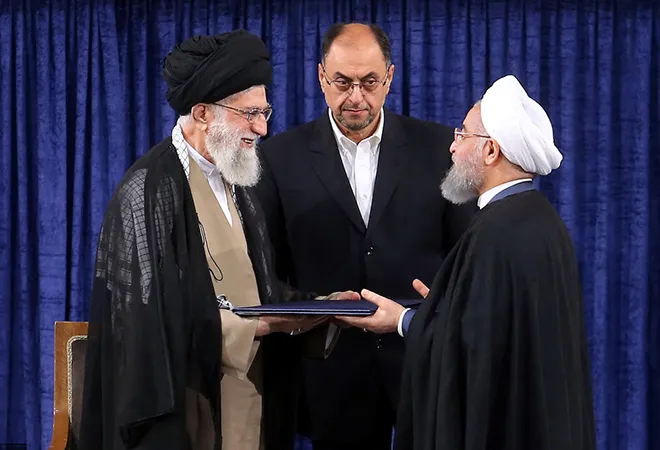Recent reports that Iran’s Transport and Urban Development Minister Mohammed Eslami had launched the track laying programme for the 628 km long rail link between Chabahar and Zahidan last week sparked concerns that India was being excluded from the project. Iran has since clarified that it is not the case and India could join the project at a later stage. This keeps the door open for Ircon International Limited (IRCON) which has been associated with the project even as India continues with the development of Chabahar port.
Connectivity for Afghanistan
Providing connectivity for Afghanistan through Iran in order to lessen its dependence on Karachi port has enjoyed support in Delhi, Kabul and Tehran since 2003. Chabahar port on Iran’s Makran coast, just 1,000 km from Kandla, is well situated but road and rail links from Chabahar to Zahidan and then 200 km further on to Zaranj in Afghanistan, need to be built. With Iran under sanctions during the Ahmadinejad years (2005-13), there was little progress. IRCON had prepared engineering studies estimating that the 800 km long railway project would need an outlay of $1.6 billion. Meanwhile, India concentrated on the 220 km road to connect Zaranj to Delaram on the Herat highway. This was completed in 2008 at a cost of $150 million.
Things moved forward after 2015 when sanctions on Iran eased with the signing of the Joint Comprehensive Plan of Action, or the Iran nuclear deal. A memorandum of understanding (MoU) was signed with Iran during Prime Minister Narendra Modi’s visit to Tehran in 2016 to equip and operate two terminals at the Shahid Beheshti port as part of Phase I of the project. Another milestone was the signing of the Trilateral Agreement on Establishment of International Transport and Transit Corridor between Afghanistan, Iran and India. In addition to $85 million of capital investment, India also committed to provide a line of credit of $150 million for port container tracks. Phase I was declared operational in 2018 and India’s wheat shipments to Afghanistan have been using this route. A special economic zone (SEZ) at Chabahar was planned but re-imposition of U.S. sanctions has slowed investments into the SEZ.
India was given a waiver from U.S. sanctions to continue cooperation on Chabahar as it contributed to Afghanistan’s development. Despite the waiver, the project has suffered delays because of the time taken by the U.S. Treasury to actually clear the import of heavy equipment such as rail mounted gantry cranes, mobile harbour cranes, etc.
India was given a waiver from U.S. sanctions to continue cooperation on Chabahar as it contributed to Afghanistan’s development. Despite the waiver, the project has suffered delays because of the time taken by the U.S. Treasury to actually clear the import of heavy equipment such as rail mounted gantry cranes, mobile harbour cranes, etc.
With regard to the rail-track project, a financing MoU was signed under which India undertook to provide $500 million worth of rolling stock and signalling equipment including $150 million of steel rail tracks. In fact, the railway tracks currently being laid are those supplied by IRCON. Iranian responsibility was for local works of land levelling and procurement. The MoU between IRCON and Iran’s Construction and Development of Transportation Infrastructures Company (CDTIC) expired last year. Further, Khatab al Anbiya, the Iranian company undertaking some of the works, was listed by the U.S. as special designated entity, leading IRCON to suggest to the Iranians to appoint another contractor.
Meanwhile, Iran has ambitious plans to extend the railway line from Zahidan to Mashad (about 1,000 km) and then another 150 km onwards to Sarakhs on the border with Turkmenistan. Another plan is to link it with the International North-South Transport Corridor towards Bandar Anzali on the Caspian Sea. In 2011, a consortium of seven Indian companies led by Steel Authority of India Limited had also successfully bid for mining rights at Hajigak mines in Afghanistan that contain large reserves of iron ore. However, developments at Hajigak remain stalled because of the precarious security situation in Afghanistan continues.
Why Iran needs China
In January 2016, just as sanctions were eased, Chinese President Xi Jinping visited Tehran and proposed a long-term comprehensive, strategic partnership programme that would involve Chinese investment in Iranian infrastructure and assured supplies of Iranian oil and gas at concessional rates. Reluctant to be tied into too close a Chinese embrace, Iran kept the negotiations going for years. China patiently permitted a limited barter trade; China Petroleum & Chemical Corporation (SINOPEC) prolonged its negotiations on developing the Yadavaran oilfield while China National Petroleum Corporation (CNPC) pulled out of the South Pars gas project last year, after initially promising to take over the French company Total’s stake.
Meanwhile, tensions in the region have been growing since last year with missile strikes in Saudi Arabia claimed by the Houthis and a U.S. drone strike in January killing Islamic Revolutionary Guard Corps (IRGC) chief Gen. Qassim Soleimani. During the last four weeks, there have been more than half-a-dozen mysterious explosions including at the ballistic missile liquid fuel production facility at Khojir, the advanced centrifuge assembly shed in Natanz and the shipyard at Bushehr. Reports attribute these to U.S. and Israeli agencies in an attempt to provoke Iran before the U.S. elections.
In May, the U.S. announced that it wanted the UN Security Council (UNSC) to continue the ban on Iranian acquisition of conventional weapons. UNSC Resolution 2231 was adopted in July 2015 by consensus to endorse the JCPOA and contains a five-year restriction on Iran’s importing conventional weapons that ends on October 18. Even though the U.S. unilaterally quit the JCPOA, it is threatening to invoke the automatic snapback of sanctions provisions of JCPOA. The United Kingdom and France have criticised the U.S.’s duplicity but are unlikely to exercise a veto. At the same time, Iran hopes that November may bring about a change in the White House that opens options for dialogue.
Even though the U.S. unilaterally quit the JCPOA, it is threatening to invoke the automatic snapback of sanctions provisions of JCPOA. The United Kingdom and France have criticised the U.S.’s duplicity but are unlikely to exercise a veto
Tehran’s balancing act
Just as it has been a tricky exercise for India to navigate between the U.S. and Iran to keep the Chabahar project going, the Rouhani administration has found it a difficult balancing act to manage the hardliners at home while coping with Trump administration’s policy of ‘maximum pressure’.
Russia and China are the only countries to veto the U.S.’s moves in the UNSC. Even so, the Iran- China comprehensive, strategic partnership road map has run into opposition in the Majlis. After the recent elections, the Reformists are down from 120 seats to 20 while the Principlists (Conservatives) are up from 86 to 221 seats in a house of 290 members. A former IRGC Air Force commander, Mohammed Bagher Ghalibaf, former Mayor of Tehran who ran unsuccessfully for president against Mr. Rouhani in 2013 and 2017 has been elected the new Speaker. Hard liners have accused Foreign Minister Mohammad Javad Zarif of undue secrecy surrounding the agreement amid rumours that China may be taking over Kish island and that Chinese troops would be stationed in Iran to secure Chinese companies and investments.
Advantages and a lesson
Iran may well be considering a long-term partnership with China, but Iranian negotiators are wary of growing Chinese mercantilist tendencies. It is true that China has greater capacity to resist U.S. sanctions compared to India but Iran realises the advantage of working with its only partner that enjoys a sanctions waiver from U.S. for Chabahar since it provides connectivity for land-locked Afghanistan. Iran and India also share an antipathy to a Taliban takeover in Afghanistan. This is why Iran would like to keep the door open. Nevertheless, India needs to improve its implementation record of infrastructure projects that it has taken up in its neighbourhood. There are numerous tales of Indian cooperation projects in Nepal, Bangladesh, Sri Lanka, Myanmar, etc suffering delays and cost overruns that only make it easier for China to expand its footprint in India’s neighbourhood. The key is to continue to remain politically engaged with Iran so that there is a better appreciation of each other’s sensitivities and compulsions.
This commentary originally appeared in The Hindu.
The views expressed above belong to the author(s). ORF research and analyses now available on Telegram! Click here to access our curated content — blogs, longforms and interviews.




 PREV
PREV


